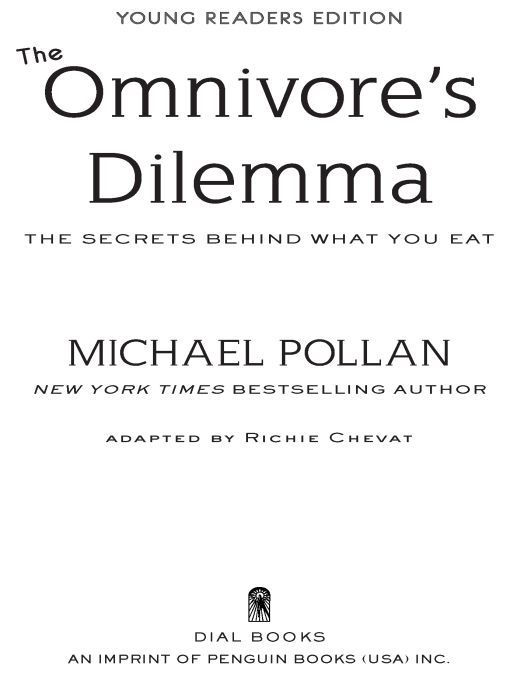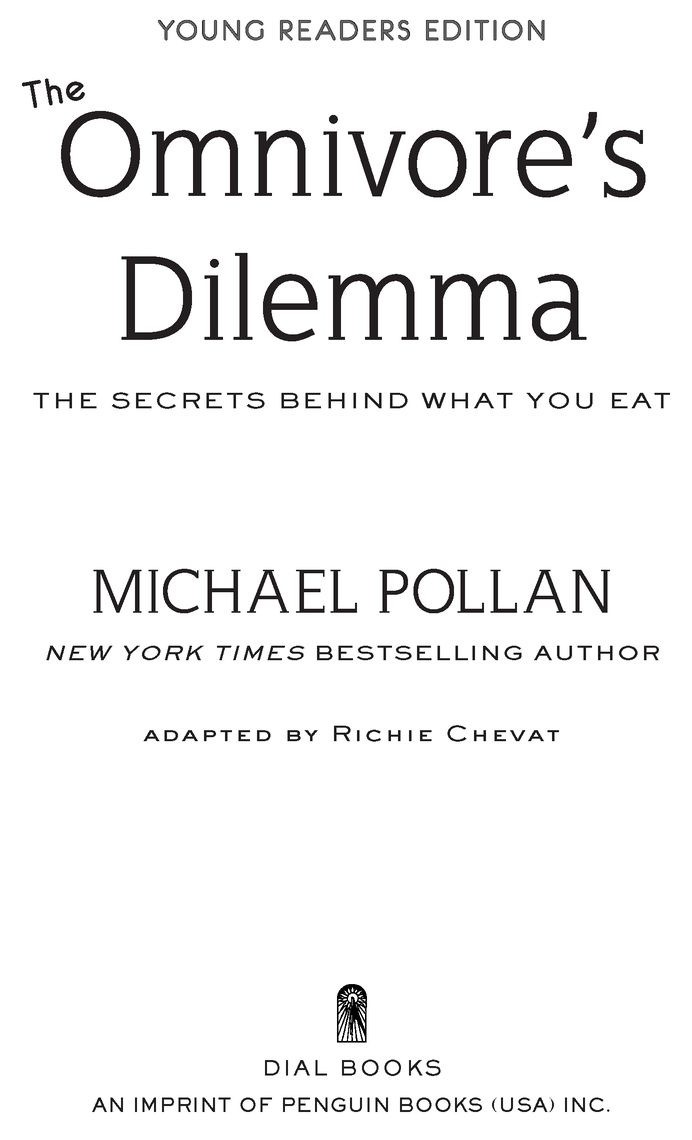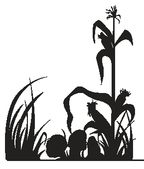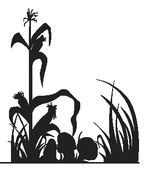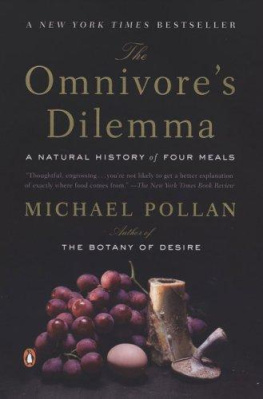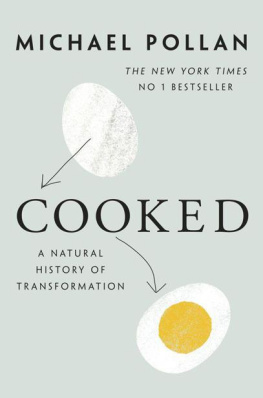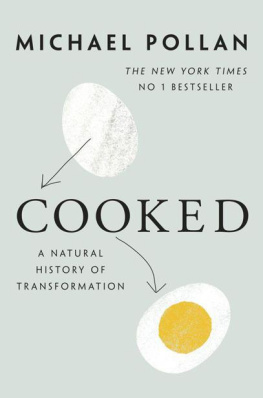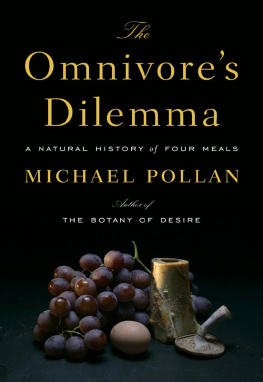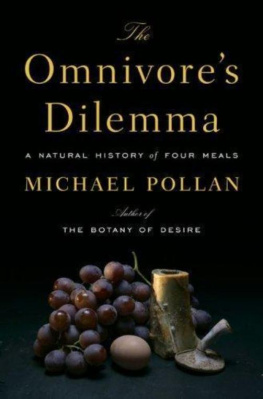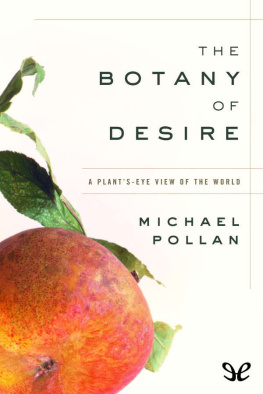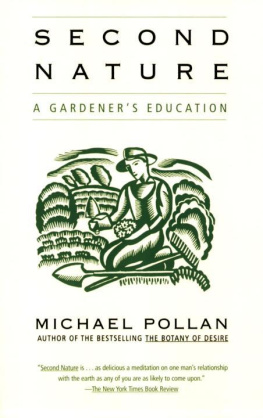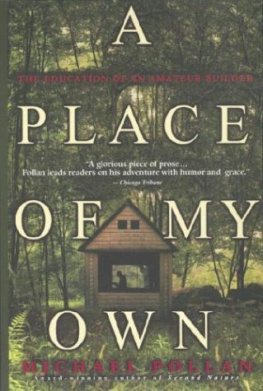Table of Contents
For Judith and Isaac
INTRODUCTION
Before I began working on this book, I never gave much thought to where my food came from. I didnt spend much time worrying about what I should and shouldnt eat. Food came from the supermarket and as long as it tasted good, I ate it.
Until, that is, I had the chance to peer behind the curtain of the modern American food chain. This came in 1998. I was working on an article about genetically modified foodfood created by changing plant DNA in the laboratory. My reporting took me to the Magic Valley in Idaho, where most of the french fries youve ever eaten begin their life as Russet Burbank potatoes. There I visited a farm like no farm Id ever seen or imagined.
It was fifteen thousand acres, divided into 135-acre crop circles. Each circle resembled the green face of a tremendous clock with a slowly rotating second hand. That sweeping second hand was the irrigation machine, a pipe more than a thousand feet long that delivered a steady rain of water, fertilizer, and pesticide to the potato plants. The whole farm was managed from a bank of computer monitors in a control room. Sitting in that room, the farmer could, at the flick of a switch, douse his crops with water or whatever chemical he thought they needed.
One of these chemicals was a pesticide called Monitor, used to control bugs. The chemical is so toxic to the nervous system that no one is allowed in the field for five days after it is sprayed. Even if the irrigation machine breaks during that time, farmers wont send a worker out to fix it because the chemical is so dangerous. Theyd rather let that whole 135-acres crop of potatoes dry up and die.
That wasnt all. During the growing season, some pesticides get inside the potato plant so that they will kill any bug that takes a bite. But these pesticides mean people cant eat the potatoes while theyre growing, either. After the harvest, the potatoes are stored for six months in a gigantic shed. Here the chemicals gradually fade until the potatoes are safe to eat. Only then can they be turned into french fries.
Thats how we grow potatoes?
I had no idea.
A BURGER WITH YOUR FRIES?
A few years later, while working on another story, I found myself driving down Interstate 5, the big highway that runs between San Francisco and Los Angeles. I was on my way to visit a farmer in Californias Central Valley. It was one of those gorgeous autumn days when the hills of California are gold. Out of nowhere, a really nasty smell assaulted my nostrilsthe stench of a gas station restroom sorely in need of attention. But I could see nothing that might explain the smellall around me were the same blue skies and golden hills.
And then, very suddenly, the golden hills turned jet-black on both sides of the highway: black with tens of thousands of cattle crowded onto a carpet of manure that stretched as far as the eye could see. I was driving through a feedlot, with tens of thousands of animals bellying up to a concrete trough that ran along the side of the highway for what seemed like miles. Behind them rose two vast pyramids, one yellow, the other black: a pile of corn and a pile of manure. The cattle, I realized, were spending their days transforming the stuff of one pile into the stuff of the other.
This is where our meat comes from?
I had no idea.
Suddenly that happy meal of hamburger and fries looked a lot less happy. Between the feedlot and the potato farm, I realized just how little I knew about the way our food is produced. The picture in my head, of small family farms with white picket fences and red barns and happy animals on green pastures, was seriously out of date.
THE OMNIVORES DILEMMA
Now I had a big problem. I went from never thinking about where my food came from to thinking about it all the time. I started worrying about what I should and shouldnt eat. Just because food was in the supermarket, did that mean it was good to eat?
The more I studied and read about food the more I realized I was suffering from a form of the omnivores dilemma. This is a big name for a very old problem. Human beings are omnivores. That means we eat plants, meat, mushroomsjust about anything. But because we are omnivores we have very little built-in instinct that tells us which foods are good for us and which arent. Thats the dilemmawe can eat anything, but how do we know what to eat?
The omnivores dilemma has been around a long time. But today we have a very modern form of this dilemma. We have a thousand choices of food in our supermarkets, but we dont really know where our food comes from. As I discovered, just finding out how our potatoes are grown might scare you off french fries for the rest of your life.
In the past, people knew about food because they grew it or hunted it themselves. They learned about food from their parents and grandparents. They cooked and ate the same foods people in their part of the world had always eaten. Modern Americans dont have strong food traditions. Instead we have dozens of different experts who give us lots of different advice about what to eat and what not to eat.
Its one thing to be crazy about food because you like to eat. But I found I was going crazy from worrying about food. So I set out to try to solve the modern omnivores dilemma. I decided to become a food detective, to find out where our food comes from and what exactly it is we are eating. My detective work became the book you now hold in your hands.
FOUR MEALS
As a food detective, I had to go back to the beginning, to the farms and fields where our food is grown. Then I followed it each step of the way, and watched what happened to our food on its way to our stomachs. Each step was another link in a chaina food chain.
A food chain is a system for growing, making, and delivering food. In this book, I follow four different food chains. Each one has its own section. They are:
Industrial
This is where most of our food comes from today. This chain starts in a giant field, usually in the Midwest, where a single crop is growncorn, or perhaps soybeansand ends up in a supermarket or fast-food restaurant.
Industrial Organic
This food is grown on large industrial farms, but with only natural fertilizers, and natural bug and weed control. It is sold in the same way as industrial food.
Local Sustainable
This is food grown on small farms that raise lots of different kinds of crops and animals. The food from the farm doesnt need to be processed, and it travels a short distanceto a farmers market, for examplebefore it reaches your table.
Hunter-Gatherer
This is the oldest type of food chain there is. Its hardly a chain at all, really. It is made up simply of you, hunting, growing, or finding your food.
All these food chains end the same waywith a meal. And so I thought it important to end each section of the book with a meal, whether it was a fast-food hamburger eaten in a speeding car, or a meal I made myself from start to finish.

